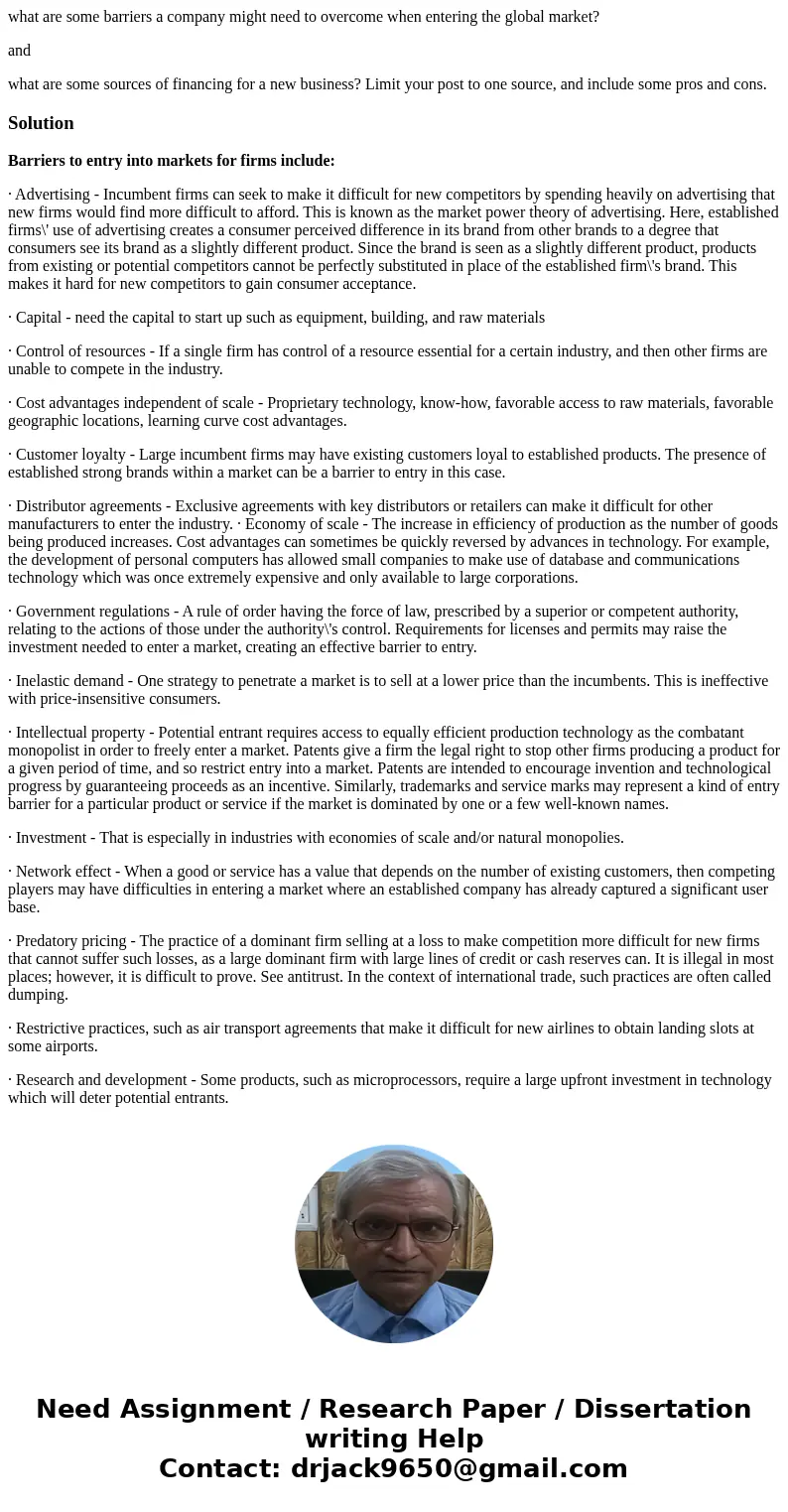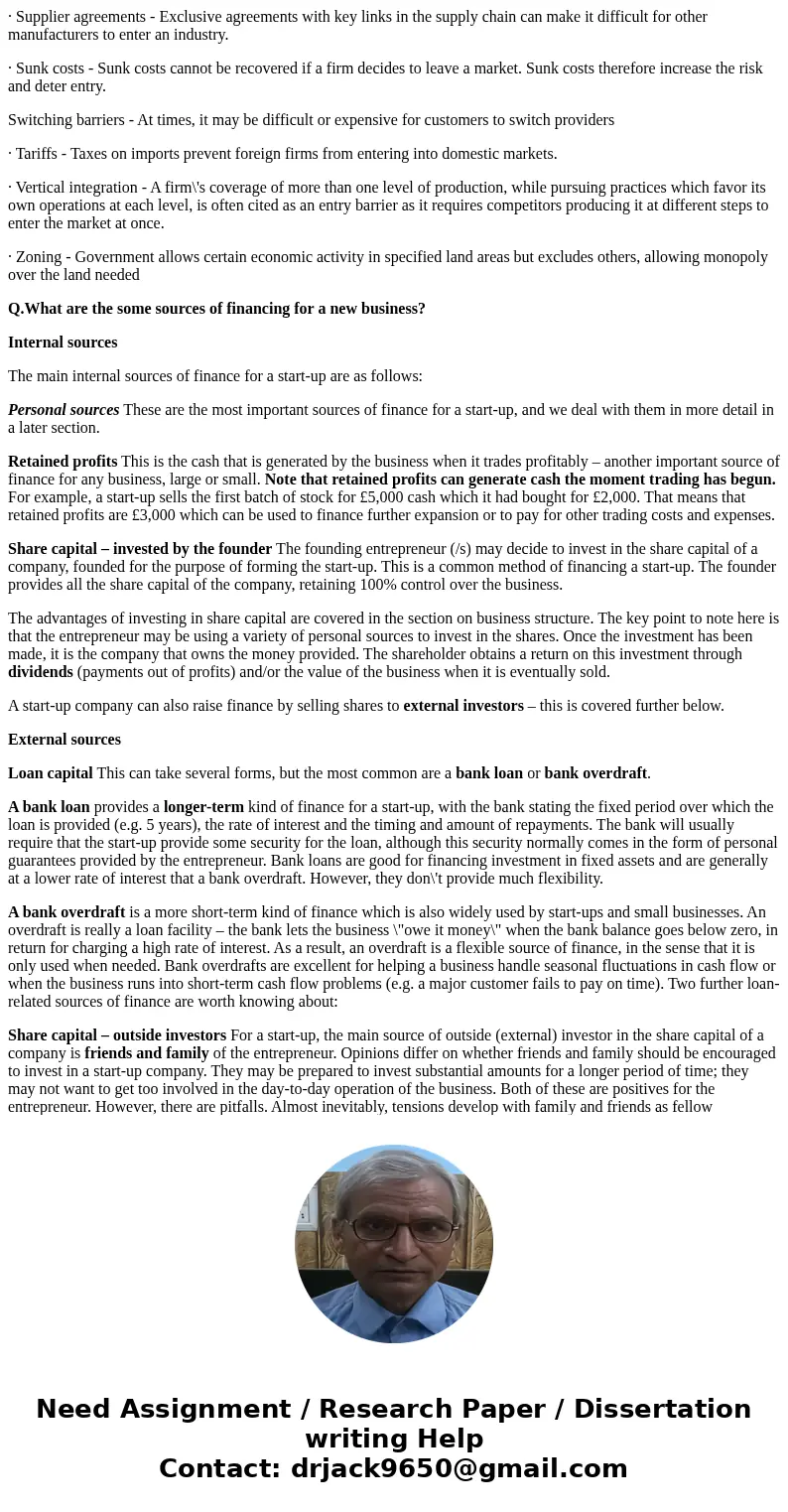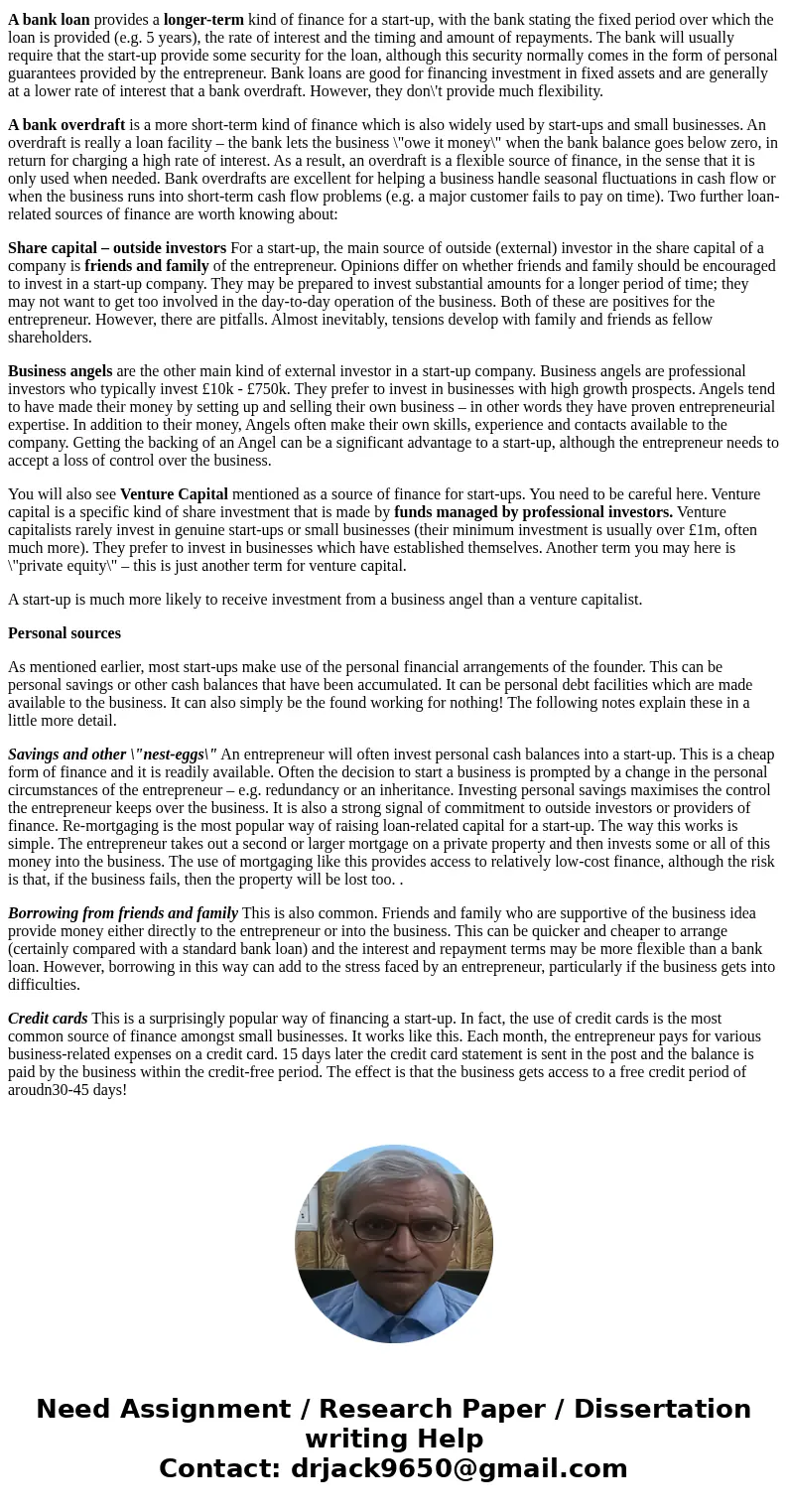what are some barriers a company might need to overcome when
what are some barriers a company might need to overcome when entering the global market?
and
what are some sources of financing for a new business? Limit your post to one source, and include some pros and cons.
Solution
Barriers to entry into markets for firms include:
· Advertising - Incumbent firms can seek to make it difficult for new competitors by spending heavily on advertising that new firms would find more difficult to afford. This is known as the market power theory of advertising. Here, established firms\' use of advertising creates a consumer perceived difference in its brand from other brands to a degree that consumers see its brand as a slightly different product. Since the brand is seen as a slightly different product, products from existing or potential competitors cannot be perfectly substituted in place of the established firm\'s brand. This makes it hard for new competitors to gain consumer acceptance.
· Capital - need the capital to start up such as equipment, building, and raw materials
· Control of resources - If a single firm has control of a resource essential for a certain industry, and then other firms are unable to compete in the industry.
· Cost advantages independent of scale - Proprietary technology, know-how, favorable access to raw materials, favorable geographic locations, learning curve cost advantages.
· Customer loyalty - Large incumbent firms may have existing customers loyal to established products. The presence of established strong brands within a market can be a barrier to entry in this case.
· Distributor agreements - Exclusive agreements with key distributors or retailers can make it difficult for other manufacturers to enter the industry. · Economy of scale - The increase in efficiency of production as the number of goods being produced increases. Cost advantages can sometimes be quickly reversed by advances in technology. For example, the development of personal computers has allowed small companies to make use of database and communications technology which was once extremely expensive and only available to large corporations.
· Government regulations - A rule of order having the force of law, prescribed by a superior or competent authority, relating to the actions of those under the authority\'s control. Requirements for licenses and permits may raise the investment needed to enter a market, creating an effective barrier to entry.
· Inelastic demand - One strategy to penetrate a market is to sell at a lower price than the incumbents. This is ineffective with price-insensitive consumers.
· Intellectual property - Potential entrant requires access to equally efficient production technology as the combatant monopolist in order to freely enter a market. Patents give a firm the legal right to stop other firms producing a product for a given period of time, and so restrict entry into a market. Patents are intended to encourage invention and technological progress by guaranteeing proceeds as an incentive. Similarly, trademarks and service marks may represent a kind of entry barrier for a particular product or service if the market is dominated by one or a few well-known names.
· Investment - That is especially in industries with economies of scale and/or natural monopolies.
· Network effect - When a good or service has a value that depends on the number of existing customers, then competing players may have difficulties in entering a market where an established company has already captured a significant user base.
· Predatory pricing - The practice of a dominant firm selling at a loss to make competition more difficult for new firms that cannot suffer such losses, as a large dominant firm with large lines of credit or cash reserves can. It is illegal in most places; however, it is difficult to prove. See antitrust. In the context of international trade, such practices are often called dumping.
· Restrictive practices, such as air transport agreements that make it difficult for new airlines to obtain landing slots at some airports.
· Research and development - Some products, such as microprocessors, require a large upfront investment in technology which will deter potential entrants.
· Supplier agreements - Exclusive agreements with key links in the supply chain can make it difficult for other manufacturers to enter an industry.
· Sunk costs - Sunk costs cannot be recovered if a firm decides to leave a market. Sunk costs therefore increase the risk and deter entry.
Switching barriers - At times, it may be difficult or expensive for customers to switch providers
· Tariffs - Taxes on imports prevent foreign firms from entering into domestic markets.
· Vertical integration - A firm\'s coverage of more than one level of production, while pursuing practices which favor its own operations at each level, is often cited as an entry barrier as it requires competitors producing it at different steps to enter the market at once.
· Zoning - Government allows certain economic activity in specified land areas but excludes others, allowing monopoly over the land needed
Q.What are the some sources of financing for a new business?
Internal sources
The main internal sources of finance for a start-up are as follows:
Personal sources These are the most important sources of finance for a start-up, and we deal with them in more detail in a later section.
Retained profits This is the cash that is generated by the business when it trades profitably – another important source of finance for any business, large or small. Note that retained profits can generate cash the moment trading has begun. For example, a start-up sells the first batch of stock for £5,000 cash which it had bought for £2,000. That means that retained profits are £3,000 which can be used to finance further expansion or to pay for other trading costs and expenses.
Share capital – invested by the founder The founding entrepreneur (/s) may decide to invest in the share capital of a company, founded for the purpose of forming the start-up. This is a common method of financing a start-up. The founder provides all the share capital of the company, retaining 100% control over the business.
The advantages of investing in share capital are covered in the section on business structure. The key point to note here is that the entrepreneur may be using a variety of personal sources to invest in the shares. Once the investment has been made, it is the company that owns the money provided. The shareholder obtains a return on this investment through dividends (payments out of profits) and/or the value of the business when it is eventually sold.
A start-up company can also raise finance by selling shares to external investors – this is covered further below.
External sources
Loan capital This can take several forms, but the most common are a bank loan or bank overdraft.
A bank loan provides a longer-term kind of finance for a start-up, with the bank stating the fixed period over which the loan is provided (e.g. 5 years), the rate of interest and the timing and amount of repayments. The bank will usually require that the start-up provide some security for the loan, although this security normally comes in the form of personal guarantees provided by the entrepreneur. Bank loans are good for financing investment in fixed assets and are generally at a lower rate of interest that a bank overdraft. However, they don\'t provide much flexibility.
A bank overdraft is a more short-term kind of finance which is also widely used by start-ups and small businesses. An overdraft is really a loan facility – the bank lets the business \"owe it money\" when the bank balance goes below zero, in return for charging a high rate of interest. As a result, an overdraft is a flexible source of finance, in the sense that it is only used when needed. Bank overdrafts are excellent for helping a business handle seasonal fluctuations in cash flow or when the business runs into short-term cash flow problems (e.g. a major customer fails to pay on time). Two further loan-related sources of finance are worth knowing about:
Share capital – outside investors For a start-up, the main source of outside (external) investor in the share capital of a company is friends and family of the entrepreneur. Opinions differ on whether friends and family should be encouraged to invest in a start-up company. They may be prepared to invest substantial amounts for a longer period of time; they may not want to get too involved in the day-to-day operation of the business. Both of these are positives for the entrepreneur. However, there are pitfalls. Almost inevitably, tensions develop with family and friends as fellow shareholders.
Business angels are the other main kind of external investor in a start-up company. Business angels are professional investors who typically invest £10k - £750k. They prefer to invest in businesses with high growth prospects. Angels tend to have made their money by setting up and selling their own business – in other words they have proven entrepreneurial expertise. In addition to their money, Angels often make their own skills, experience and contacts available to the company. Getting the backing of an Angel can be a significant advantage to a start-up, although the entrepreneur needs to accept a loss of control over the business.
You will also see Venture Capital mentioned as a source of finance for start-ups. You need to be careful here. Venture capital is a specific kind of share investment that is made by funds managed by professional investors. Venture capitalists rarely invest in genuine start-ups or small businesses (their minimum investment is usually over £1m, often much more). They prefer to invest in businesses which have established themselves. Another term you may here is \"private equity\" – this is just another term for venture capital.
A start-up is much more likely to receive investment from a business angel than a venture capitalist.
Personal sources
As mentioned earlier, most start-ups make use of the personal financial arrangements of the founder. This can be personal savings or other cash balances that have been accumulated. It can be personal debt facilities which are made available to the business. It can also simply be the found working for nothing! The following notes explain these in a little more detail.
Savings and other \"nest-eggs\" An entrepreneur will often invest personal cash balances into a start-up. This is a cheap form of finance and it is readily available. Often the decision to start a business is prompted by a change in the personal circumstances of the entrepreneur – e.g. redundancy or an inheritance. Investing personal savings maximises the control the entrepreneur keeps over the business. It is also a strong signal of commitment to outside investors or providers of finance. Re-mortgaging is the most popular way of raising loan-related capital for a start-up. The way this works is simple. The entrepreneur takes out a second or larger mortgage on a private property and then invests some or all of this money into the business. The use of mortgaging like this provides access to relatively low-cost finance, although the risk is that, if the business fails, then the property will be lost too. .
Borrowing from friends and family This is also common. Friends and family who are supportive of the business idea provide money either directly to the entrepreneur or into the business. This can be quicker and cheaper to arrange (certainly compared with a standard bank loan) and the interest and repayment terms may be more flexible than a bank loan. However, borrowing in this way can add to the stress faced by an entrepreneur, particularly if the business gets into difficulties.
Credit cards This is a surprisingly popular way of financing a start-up. In fact, the use of credit cards is the most common source of finance amongst small businesses. It works like this. Each month, the entrepreneur pays for various business-related expenses on a credit card. 15 days later the credit card statement is sent in the post and the balance is paid by the business within the credit-free period. The effect is that the business gets access to a free credit period of aroudn30-45 days!



 Homework Sourse
Homework Sourse